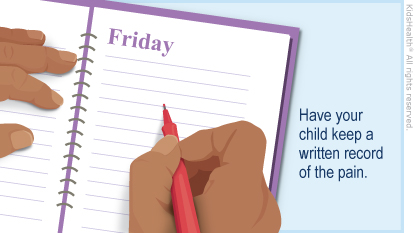Pelvic Pain: How to Care for Your Child
Pelvic pain (pain in the lower belly) can happen for lots of different reasons. The pain might be steady or come and go. It can help to keep a record of the pain. When the cause of the pain is found, your health care provider will help you find the best treatment.


-
Have your child keep a written record of pain. This should include:
-
the date and time when the pain happens
-
how bad the pain is (using a scale of 1–10 where 1 means just a little uncomfortable and 10 means the worst pain ever)
-
what they're doing when they get the pain
-
what makes the pain go away
-
when their period starts and ends if they are menstruating
-
when they poop
-
You can give medicine for pain if your health care provider says it's OK. Use these medicines exactly as directed:
-
acetaminophen (such as Tylenol® or a store brand)OR
-
ibuprofen (such as Advil®, Motrin®, or a store brand)
-
Don't give aspirin to your child or teen as it could lead to a rare but serious illness called Reye syndrome.
-
Don't give laxatives, antacids, or other medicines unless recommended by the health care provider.
-
Go to any follow-up care visits as instructed by the health care provider.

-
Your child develops new symptoms such as pain when peeing, a fever, discharge from the vagina or penis, vomiting, or blood in the poop.
-
The pain gets worse.
-
Your child can't go to school or enjoy usual activities because of the pain.

Your child has severe pain.

What causes pelvic pain? Causes of pelvic pain include:
-
infection
-
irritated bladder
-
endometriosis (when uterine tissue grows outside of the uterus it may cause pain, especially during periods)
-
period cramps
-
muscle pain
-
problems in the intestines
-
constipation
What tests are done to find the cause of pelvic pain? Depending on other symptoms, the health care provider might do:
-
a physical exam, possibly including a pelvic exam
-
tests on blood and pee
-
an ultrasound
-
less commonly, a laparoscopy (looking inside the belly with a thin tube that has a camera on the end)